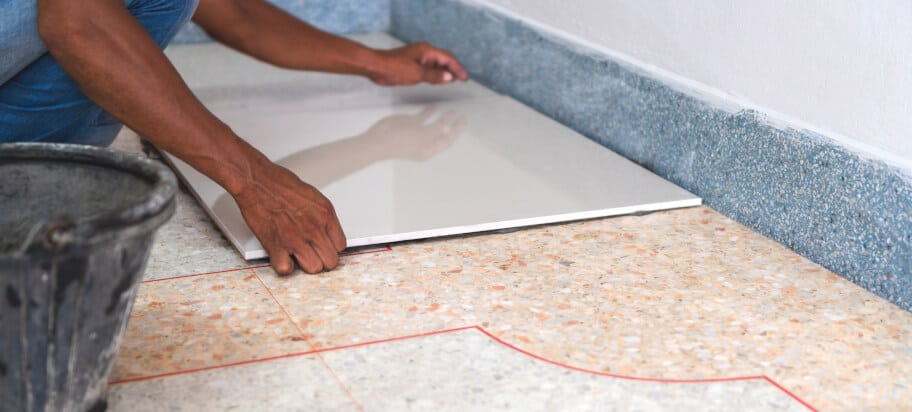Understanding the Importance of Grouting
When it comes to achieving the perfect finish in any tiling project, one factor that plays a crucial role yet often overlooked, is grouting. Understanding what grouting is and why it matters can help ensure successful results, whether you’re a professional contractor or a DIY enthusiast.
What is Grouting?
Grouting, in the context of tiling, is the process of filling the spaces or joints between tiles with a material known as grout. Grout is typically a mixture of water, cement, and sometimes sand, which hardens over time to provide stability, prevent water intrusion, and complete the aesthetic look of a tiled surface.
There are different types of grout, including non-sanded, sanded, and epoxy grout, each with its own properties and uses. Selecting the right grout for your project depends on a variety of factors, including the type of tile, size of tile joints, and the area where the tiles are installed.
Why Grout Matters in Tiling
While grouting might seem like a minor aspect of tiling, it has a significant impact on both the durability and appearance of the tiled surface. Here’s why grout matters:
- Durability: Grout helps to secure tiles in place and distribute weight evenly. This increases the longevity of the tiled surface, preventing tiles from cracking or moving over time.
- Water Resistance: A well-grouted surface can prevent water from seeping through the tile joints, making it crucial in areas exposed to moisture, such as bathrooms and kitchens.
- Aesthetics: Grout comes in various colors, allowing for design flexibility. Choosing the right grout color can enhance the overall look of your tiled surface, making the tiles stand out or blend together seamlessly.
- Maintenance: Grout acts as a barrier against dirt and spills, making cleaning and maintenance easier. However, grout itself can become stained over time and may require regular cleaning or even replacement to maintain its appearance.
In the following sections, we will delve deeper into how to choose the right grout, prepare the tile surface, apply the grout, and more. By understanding and applying the right grouting techniques, you can achieve perfect finishes every time and ensure the longevity and beauty of your tiling projects.
Prepping for Grouting
Before diving into grouting techniques, it’s essential to prepare appropriately. This involves selecting the correct grout and ensuring the tile surface is ready for the process.
Choosing the Right Grout
Choosing the appropriate grout is a critical step in achieving a perfect finish every time. Grout comes in various types, each suited to different tiling applications. These can be broadly categorized into two types: sanded and unsanded.
Sanded grout is typically used for larger grout lines and is ideal for floor tiles due to its durability and resistance to cracking. On the other hand, unsanded grout is best suited for smaller grout lines and delicate tile surfaces, as it is less abrasive.
When choosing grout, also consider the color. It can either complement or contrast the tiles, depending on the desired aesthetic. For more guidance on selecting the right materials for your project, refer to our article on understanding tile adhesives: a complete guide.
Preparing the Tile Surface
Once the right grout is selected, the next step is to prepare the tile surface. The tiles should be clean, dry, and free of any dust or debris. Any spacers used during the tiling process should also be removed.
Next, check the tile surface for any uneven areas. If any are found, they should be smoothed out before grouting begins. This ensures that the grout application is even and consistent across the entire surface.
Remember, taking the time to prepare is a critical part of achieving a professional-looking finish. For more tips on tiling preparation and application, see our grouting techniques for perfect finishes every time guide.
With the right grout chosen and the tile surface prepared, you are ready to move on to the grouting process. Proper preparation lays the foundation for a successful tiling project, leading to results that are both beautiful and durable.
Grouting Techniques for Perfect Finishes
When it comes to achieving a professional, clean finish with your tiles, implementing the right grouting techniques is key. This section will guide you through three essential steps: applying the grout, smoothing and shaping, and cleaning excess grout.
Applying the Grout
The first step in grouting is applying the grout to the tile surface. Start by loading your grout float with a generous amount of grout. Then, spread the grout diagonally across the tiles, pressing firmly to ensure the grout penetrates into the gaps between the tiles. Repeat this process until all the joints are filled. Remember to refill your float frequently to maintain a consistent application.
Maintaining a 45-degree angle with your grout float is crucial during this process. This angle allows the grout to be effectively pushed into the joints, ensuring a solid and durable finish. Be patient and thorough during this process; rushing may result in uneven grout lines or gaps, diminishing the quality of the end result.
Smoothing and Shaping
Once the grout has been applied, the next step is to smooth and shape the grout lines. This involves running a grout float or a damp sponge diagonally over the tiles to remove excess grout from the tile surface and to shape the grout lines. Aim for consistency and uniformity in the depth and width of your grout lines.
Always keep your smoothing tool at a 45-degree angle to avoid digging into the grout lines. Be sure to clean your tool frequently to ensure a smooth, clean finish. Remember, the goal is to create a neat, even surface that complements your tiles.
Cleaning Excess Grout
The final step in the grouting process is cleaning up the excess grout. After the grout has had time to set (around 15-30 minutes), use a damp sponge to wipe away the grout residue from the tile surface. Rinse the sponge frequently and change the water as needed to prevent smearing grout over the clean tiles.
It’s crucial to be gentle during this process. Scrubbing too hard can pull grout out of the joints or damage the tile surface. Make sure to wipe the tiles in a circular motion to avoid dragging grout out of the joints.
By following these grouting techniques, you can achieve perfect finishes every time. However, remember that grouting is just one part of tiling. To learn more about other aspects of tiling, check out our articles on choosing the right tile for your kitchen or maximize your space: expert tips for tiling small bathrooms.
Grouting Mistakes to Avoid
As you hone your grouting techniques for perfect finishes every time, it’s equally important to be aware of common grouting mistakes. Avoiding these pitfalls can make the difference between a professional-looking finish and a tiling job that falls short of expectations.
Rushing the Process
One of the biggest mistakes that individuals make when grouting is rushing the process. Grouting is not a task that can be completed hastily. Each step, from mixing the grout to applying it to the tile joints, requires careful attention and patience.
Grout needs time to properly set and harden before it can be cleaned and sealed. If this process is rushed, it could lead to uneven grout lines or grout that easily chips and cracks over time. It’s essential to allow ample time for each step in the grouting process, ensuring a high-quality and long-lasting finish. For a deeper understanding of the process, check out our article on grouting techniques for perfect finishes every time.
Neglecting Proper Clean Up
Another common mistake is neglecting to properly clean up after grouting. Excess grout left on the tile surfaces can harden and become difficult to remove, marring the appearance of the tiles.
It’s important to wipe away excess grout using a damp sponge while the grout is still wet. Be sure to rinse the sponge frequently to avoid spreading grout residue over the tiles. Once the grout has dried, a haze may form on the tile surfaces. This can be removed using a soft cloth or a grout haze remover. Refer to our guide on how to maintain your tiled surfaces: easy cleaning tips for more cleaning advice.
Ignoring Grout Sealing
The final mistake to avoid is ignoring the crucial step of grout sealing. Grout is porous and can absorb moisture and stains if not properly sealed. Over time, this can lead to discolored and unsightly grout lines.
Applying a grout sealer after the grout has fully cured can protect it from dirt, stains, and moisture, maintaining its appearance for a longer period. Grout sealer should be reapplied every one to two years, depending on the level of traffic and use in the area.
By avoiding these common grouting mistakes, you can ensure a professional-looking finish and prolong the life of your tile work. Remember that the key to successful grouting lies in patience, attention to detail, and proper maintenance.
Maintaining Your Grout
After applying the grout and achieving a perfect finish, maintaining the grout’s cleanliness and integrity is essential for preserving the overall look and durability of your tiling. This section will share tips on regular cleaning and how to know when re-grouting is necessary.
Regular Cleaning Tips
Regular cleaning is a crucial aspect of grout maintenance. Here are some steps to help keep your grout looking its best:
- Daily Wipe Down: Use a damp cloth or sponge to wipe down the tiled areas every day. This helps remove any surface dirt or stains before they penetrate the grout.
- Weekly Cleaning: Use a mild detergent and warm water to clean the grout. Avoid harsh chemicals as they can damage the grout over time.
- Deep Cleaning: Depending on usage, deep clean your grout every few months. A mixture of baking soda and water can be used to scrub the grout lines gently. Rinse thoroughly after cleaning.
- Spot Cleaning: For stubborn stains, consider spot cleaning. Apply a paste of baking soda and water, let it sit for a few minutes, then scrub gently with a soft brush.
- Dry Thoroughly: After cleaning, ensure the area is thoroughly dried to prevent mold and mildew growth.
Regular cleaning can extend the life of your grout and maintain the aesthetic appeal of your tiling. For more tips on maintaining tiled surfaces, check out our article on how to maintain your tiled surfaces: easy cleaning tips.
When to Consider Re-Grouting
Even with the best maintenance, grout may deteriorate over time due to wear and tear, staining, or mold. Here are signs it might be time to consider re-grouting:
- Cracking or crumbling grout: If you notice cracks or crumbling in the grout, it may be time to replace it. These could be signs of age or underlying issues such as water damage.
- Persistent Staining: If despite regular cleaning, the grout remains stained or discolored, re-grouting may be necessary to restore the appearance of the tile.
- Mold and Mildew: If mold and mildew persist even after thorough cleaning, it might be time to replace the grout.
- Loose Tiles: If tiles start to loosen, it could be an indication that the grout is failing and needs replacement.
Re-grouting is a process that requires careful preparation and execution to ensure a perfect finish. If you’re uncomfortable doing it yourself, consider hiring a professional tiling contractor to ensure the job is done correctly.
Maintaining your grout not only enhances the appearance of your tile but also extends its life, ensuring your tile work remains beautiful for years to come. For more tiling insights and tips, explore our in-depth articles on tiling.



